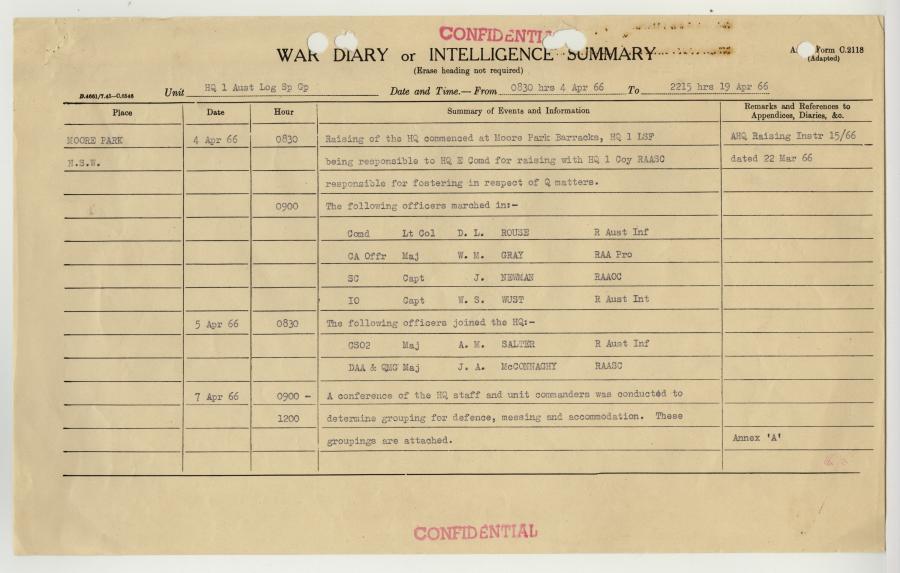The unit that became a community: 1 Australian Logistic Support Group during the Vietnam War
1ALSG sign at entrance to base area at Vung Tau. Photograph by John Geoffrey Fairley.
The Australian Army set up 1 Australian Logistics Support Group (1ALSG) at Vung Tau to provide support for the inland combat-area base at Nui Dat in Vietnam, and to combine and coordinate a variety of units in one place.

Page of 1ALSG until diary featuring establishment in April 1966. RCDIG1028217
Formally established in early April 1966, over the next five years 1ALSG became a major base, providing a range of support services and facilities, and serving as a home away from home for thousands of personnel.
In the first half of 1966, few on-site supplies were readily available. Personnel scrounged spare parts and old tents from a rubbish pile left by American units, and repair and maintenance jobs were carried out while sitting on used supply pallets. Tents had to be carefully fastened, lest they collapse into the side of a sand dune. 2 Field Ambulance, the first medical facility set up for personnel, worked out of tents and marquees until more stable workspaces were built. Veterans who served at 1ALSG, especially in its first year, remember lots of improvising, and forming close long-term friendships on a “we’re all in it together” basis.
With help from engineering units and benefiting from being away from the dangers of the front line, expansions and improvements were made. Over a few years, 1ALSG became a major base at Vung Tau, providing combat and non-combat support facilities. There were inter-unit sports events, visits from senior military and civilian leaders, and liaison with American and New Zealand units. Connections were made with Vietnamese civilians and communities through building works undertaken by 1ALSG personnel, including a new covered marketplace and classrooms for a new school.
A variety of roles were undertaken, including transport, engineering, military policing, medical, administration, and HQ operations. The base’s 1 Field Hospital provided a wide range of health and surgical services. The Royal Australian Electrical and Mechanical Engineers set up workshop facilities to undertake repair and maintenance work on vehicles and equipment needed in combat zones.
An airfield near the coast was used by RAAF C-130 crews for medevac flights, and a harbour accommodated ships including HMAS Sydney (III). Known as the “Vung Tau Ferry”, Sydney made more than 40 return trips within five years, carrying personnel and supplies from Australia. A postal unit was established to deal with thousands of pieces of mail each week.
Mail sorting by 1 ALSG’s postal unit, 1967. Photograph by Byron Charles Campbell.
Letters and phone calls helped personnel keep in contact with those at home in Australia. Telegrams could also be used for brief messages, usually notes of celebration or news of injury or death. Annual television shows featuring Christmas messages from the troops were broadcast in Australia.
Communication units were based at 1ALSG, to help deal with signalling work.
From 1966 to 1971, there was an increase in colour photography for amateur and official military uses, reflected in the photographs of life at the base.
In 1966, there was swimming and ball games at the base, but few other alternatives for recreation. By 1970, 1ALSG was recognised as a major base in its own right, attracting personnel from outside Vung Tau by providing a swimming pool, patrolled beach area, gymnasium, tennis courts, and the Badcoe Club, named after Vietnam War hero Major Peter Badcoe VC, which served as a social club as well as providing for convalescent personnel.
In 1971, de-escalation of army operations in Vietnam led to less demand for 1ALSG. Demobilisation and packing up the base became priority tasks. While Vung Tau Ferry made many return trips in 1971 and 1972, some personnel returned to Australia in C-130 aircraft that had been used for medevac flights. Thanks to 1ALSG having an airfield, personnel didn’t have to travel far to start their trips home.
During approximately five years of active service between 1966 and 1971, 1ALSG became a valuable part of Australian Army operations in Vietnam. For those working there, it became a home away from home, and an example of a unit becoming a community.
The unit war diaries for 1 Australian Logistic Support Group have been digitised and are available to view here.





